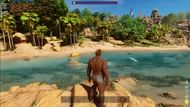Knowing how to optimize graphics settings in Ark Survival Ascended goes a long way in making the game more enjoyable. After all, you cannot indulge in some good old dino delight when stutters and FPS drops disrupt the flow of gameplay. As a UE5 game, Ark Survival Ascended is very resource intensive, but it thankfully lets you tweak a lot of its cutting-edge visual options.
This guide will take you through all the graphics settings available in Ark Survival Ascended, and help you pick the right options for your rig.
Explaining Graphics options in Ark Survival Ascended

You cannot tune graphics settings in Ark Survival Ascended without knowing what they do. Players not used to video game tech lingo may find this section helpful, but if you are familiar with UE5's effects, you can skip to the next section.
Here are all the graphics options you can access from the main menu in Ark Survival Ascended:
- Graphics Preset: This option allows you to tweak all broad graphic settings to a specific performance preset. Since we will be going over each setting individually, this option will be set to Custom in any case.
- Advanced Graphics: This one houses a great deal of effects specific to Unreal Engine 5, including changes related to Lumen, an advanced Global Illumination tech.
- View Distance: This is the distance at which objects and actors (moving creatures) render.
- Textures: This lets you alter texture resolution.
- Global Illumination Quality: Allows you to alter the accuracy of shadow-casting and environmental bump-mapping.
- Post Processing: This one involves a number of effects, including water caustics and SSAO.
- General Shadows: This option pertains to shadow resolution. You get high-performance gains on lower settings but with flickering.
- Effect Quality: This is the particle quality of VFX like smoke, fire, and so on.
- Foliage Quality: This concerns the quality and amount of grass and miscellaneous flora objects that are not resources in Ark Survival Ascended.
The main menu has several sliders on the panel to the right. Many of these are unoptimized, so it's best to leave most of them off. The exception to this rule is Sun Shafts (ON).
Low Light Enhancement may be a good quality-of-life option for PvP players, but it uses a surprisingly high amount of resources for what little it provides.
Foliage and Fluid Interaction is another special point of interest. It is reported to be heavily taxing, but the immersion it grants in return is a fair tradeoff to some. If you are running on a beefy rig that can handle it, you should cut costs elsewhere and consider turning it on. Here are the recommended graphics settings related to this option:
- Foliage Interaction Distance Multiplier: 1.5
- Foliage Interaction Distance Limit: 1.0
- Foliage Interaction Quantity Limit: 1.0
These are also some settings in the Video section you should tweak:
- Resolution: Self-explanatory, higher means more graphics-intensive.
- Window Mode: Allows you to switch between exclusive fullscreen, borderless (called windowed fullscreen in this game), or windowed mode.
- Max Frame Rate: Set to your Monitor's refresh rate.
- Resolution Scale: This setting downgrades the render resolution from the Display Resolution (the first option in the menu) by the specified perimeter. For example, if it is set at 60, your actual resolution output will be only 60% of the resolution initially set by you.
- Anti-Ailising: Low should be used in most cases, as the higher AA options in this game make it quite blurry. Use the DLSS option if available.
Also Read: Survival of The Fittest Beginner's Guide
Optimized Ark Survival Ascended Graphics Settings

For our testing, the graphics settings provided below are what we chose to use in Ark Survival Ascended. They give you some serviceable visuals while being performance-friendly enough to run on a mid-range GPU at 1920x1080 resolution (90% render resolution scaling).
The following settings are optimized for gameplay, meaning you'll have functional visibility under all circumstances and in every weather type. The settings are as follows:
- Advanced Graphics: Low
- View Distance: Medium
- Textures: High
- Post Processing: Medium
- General Shadows: Medium (set to Low if you are struggling to maintain good FPS)
- Global Illumination Quality: Low
- Effect Quality: Low
- Foliage Quality: Low
- All other effects are set to off except for Sun Shafts and Footstep Decals
If you're still struggling with performance, here is the order of graphics settings you should reduce:
- General Shadows: Introduces blocky shadows and flickering on low.
- Resolution: Allows you to tweak Resolution Scaling. As a last-ditch effort, you can lower the Resolution Scaling to under 50 and see if this improves performance.
Read along to find out some optional console commands you can enable while in-game to drastically improve performance.
Also Read: Top 5 rare creatures in Ark Survival Ascended
Ark Survival Ascended Graphics console commands for Performance gain

If you want the best performance in Ark Survival Ascended, setting all graphics options to low may be a no-brainer. However, for even more performance gains, you can make use of these console commands to disable things you otherwise cannot.
- r.VolumetricCloud 0: Turns off all Volumetric Clouds.
- sg.ShadowQuality 0: Turns off all shadows.
- r.Water.SingeLayer 0: Disables some water-related visibility effects.
- GrassDensityScale 0: Disables all grass.
- Show InstancedStaticMeshes: Toggles distant LOD objects off and on.
You can also use r.MaterialQualityLevel 0 to disable a lot of geometry rendering in the game. This makes the title understandably very performance-friendly but also an eyesore hellscape not fit for most players.
Check out our other guides to this game:
All Ark Survival Ascended Explorer Notes locations || Best Ark Survival Ascended tame for every resource || Cave locations on The Island || All Ark Survival Ascended Kibble Recipes || Ark Survival Ascended DLC Roadmap and map release schedule || Scorched Earth Resource maps
